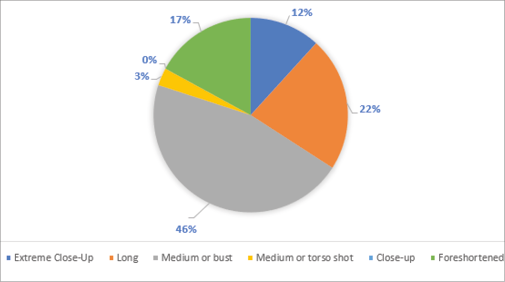218 | nº 31, pp. 207-238 | doxa.comunicación
July-December of 2020
Study on the cinematographic image composition: frame, light, and colour as expressive elements...
ISSN: 1696-019X / e-ISSN: 2386-3978
Graph 2: Percentages on the uses of different types of close-ups
Source: created by the authors
3.1.2. Colour
The Colour in Fargo has been used intentionally and dramatically. This tension is created by relating this resource to specific characters or situations. However, it is true that in this work, the use of white [absence of Colour (Heller, 2008: 164)] is omnipresent. The recurrence of white is observed in the snowy landscapes of the locations representing North Dakota and Minnesota (use of colour to give credibility to the story and show reality). It also seems to accentuate some of the characters’ lack of morals and empathy: one of the two criminals, Gaear Grimsrud (Peter Stormare), whom Jerry Lundegaard contacts (William H. Macy) to kidnap his wife, wears a white jumper throughout the whole film (figure 1). It is not insignificant that Grimsrud is a man lacking in ethics and compassion (insensitive character: cf. in table 3). Simultaneously, white contrasts with other colours, such as black and red or maroon, which also have a prominent presence in the work. Red is strictly related to death throughout the whole film through different clothing. All the characters that wear a red garment or a colour in the same range, usually maroon, end up being killed during the film. We can observe this connection for the first time during the scene where Lundegaard (Kristin Rudrüd) is kidnapped. She is knitting a maroon sweater (figure 2).
